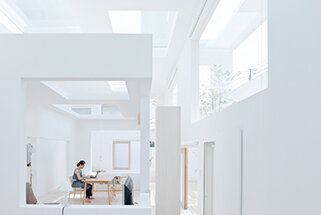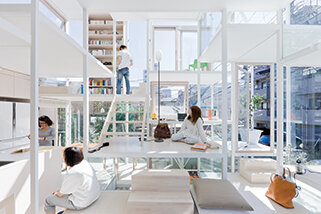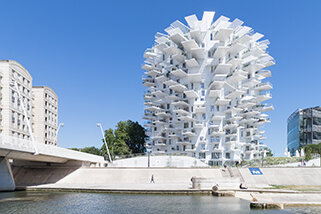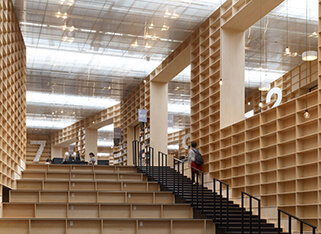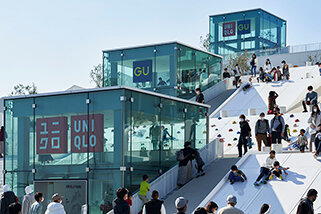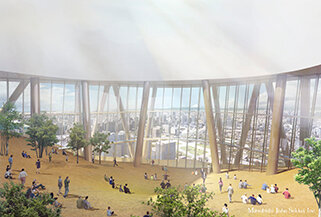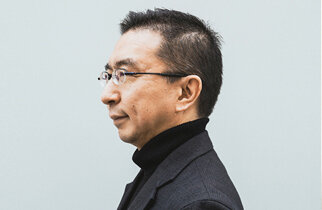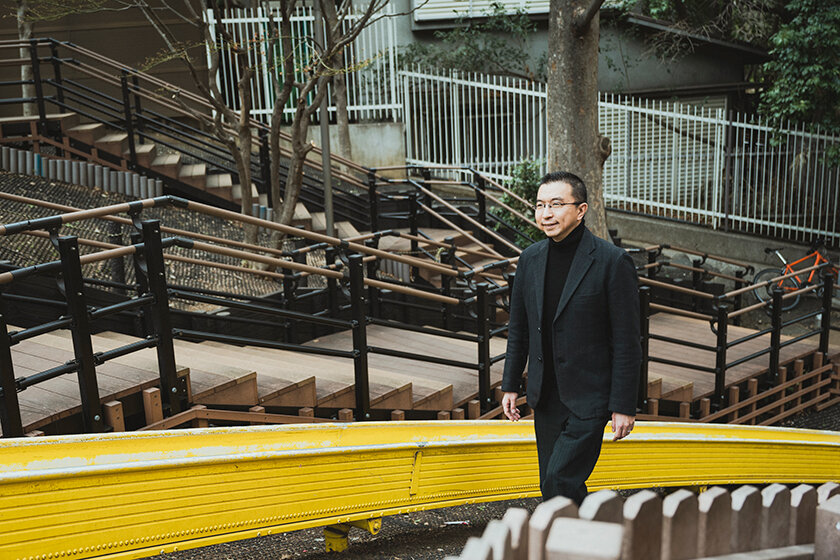
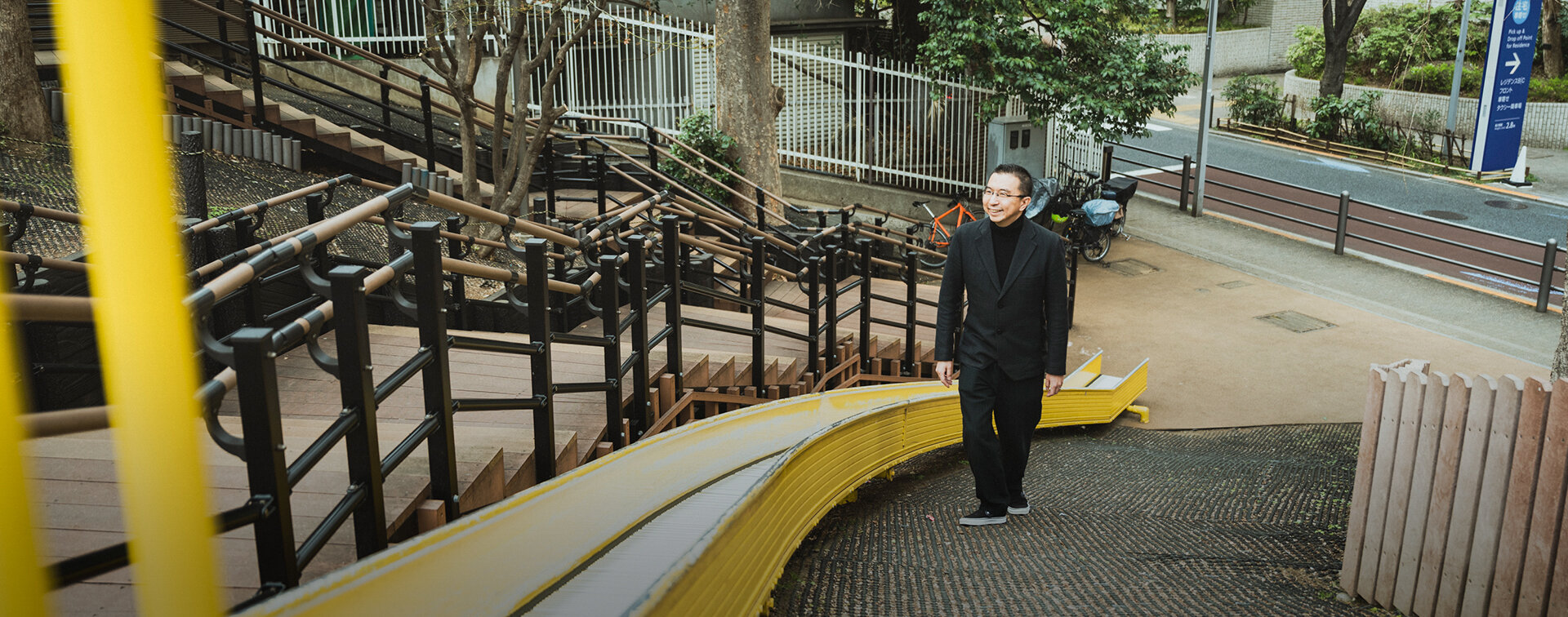
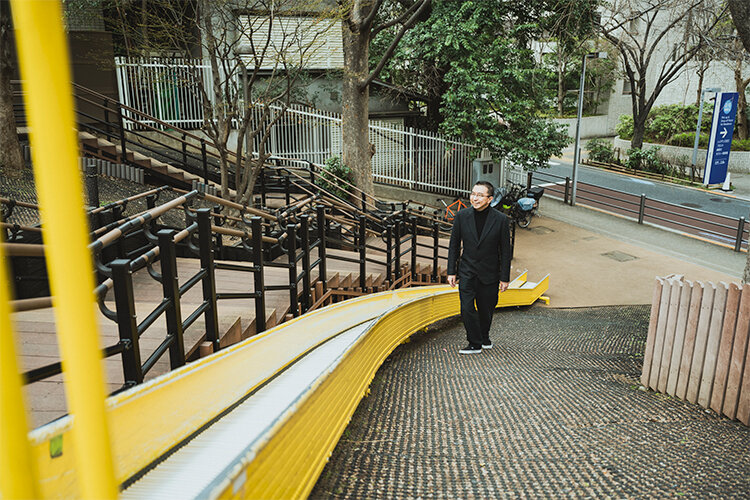
INTERVIEW
126
Sou FujimotoArchitect
Creating "spaces" where building, streets, and landscapes blend seamlessly together
The richness of the world can be found in ambiguous spaces.
In today's chaotic world, Sou Fujimoto is creating architecture that breathes life into people's lives and cities around the world. In a gradated fashion, he beautifully blends seemingly polar opposites such as the inside with the outside and the natural with the artificial, while at the same time highlighting each. Designing one-of-a-kind structures, his creations facilitate the flow of comforting air, enrich peoples' lives, and have the power to change the future. He shared a variety of perspectives on a range of topics, including his view on the ideal architectural form for cities, what he has felt during the COVID-19 pandemic, and the future for urban environments.
Architecture that does not devalue either aspect.
Architecture has an element wherein it must accommodate the diverse chaos of the world, but at the same time, I feel that is also an interesting aspect. For example, the allure of a somewhat jumbled and disorderly place like Roppongi is something that is created over time. The richness inherent there is not something that can be easily created. On the other hand, I grew up in the countryside of Hokkaido, a place overflowing with nature, so I know that artificial things alone are not enough. The house I grew up in is located in a wooded area. Among the clutter and confusion of the trees, it feels like you can wander about without really going anywhere. In a way, I believe places like Tokyo's shopping streets, with their helter-skelter and human scale, are somewhat similar.
However, as a person who understands nature's harshness firsthand, I also feel that a place friendly to both artificial and natural things has been created in Tokyo. In Tokyo, I feel that people have created a lovely city by keeping various things small and arranging them well so as not to threaten their own survival. On the other hand, if the development of huge buildings continues, the city's human scale may be lost. However, when you consider that there is a dynamism that only comes from something that is huge, it doesn't mean that everything should be small. It is not about "which" is good, but rather that "both" are good. That is why I don't want to discard either the natural or artificial, nor commit to something being only small scale or large and dynamic. I want to incorporate the charm of both. This desire is probably the starting point of my architectural views.
House N
A home designed by Mr. Fujimoto and completed in Oita in 2008. Surrounded by boxes, the inside and outside of the home is like a nested structure, with large hole-like windows scattered about the walls that allow light and wind to pass through.
Photo:IWAN BAAN
House NA
A home that creates unique spaces by combining thin floor plates stacked like shelves, and slender support pillars that stand like trees in a forest. The inside is not completely divided into private rooms, rather the spaces are connected in a loose manner.
Photo:IWAN BAAN
Blending various elements to create diverse spaces.
In a positive sense, architecture can create ambiguous spaces. Put simply, there is a kind of richness that spreads between two extremes, such as the inside and the outside, the open and the protected, the connected and the disconnected. To put it another way, if a person is living there, there is a need for places where many people can gather and also for places where an individual can spend time alone. There is charm in both orderly and disorderly things. If there is virtue in simple things, then the same holds true for complicated and chaotic things. I want to create a kind of "diversity of place" that can only be created by fusing the two.
The concept of "diversity" also varies from project to project. For example, each place has a different climate and cultural background, and its current form is also different from its past history. When I am constructing a building, I realize that no two places are the same. Furthermore, the nuances of a project change depending on the people involved. When these various and disparate elements are blended together, diversity in the form of varying places is born. In this way, we can have a variety of choices, and I feel the result will be a very rich place.
What I would like to achieve is a place that is diverse and at the same time comforting for people while also being somewhat unpredictable. Human-made objects tend to be rather monotonous, with everything often going in a predictable direction. Conversely, nature is diverse and unpredictable. That is why I believe something "just right" can be created by combining the two. I feel that this positive unpredictability that excites will serve as a hint for future cities.

For this location, this is the only way. The sense of discovery.
When it comes time to construct a building, the first thing I do is rather normal. I thoroughly research the background of the project and its location. I go to the site and talk with the people living in the area and ensure I retain the impressions I formed while there. When I think about it, ideas often come to me when I listen to the local people's stories. In the beginning, the stories are rambling and whimsical; however, various shapes and scenes come to mind with each word or phrase spoken, and gradually they connect. Various impressions, seemingly disparate at first glance, connect little by little and finally take on a single form and develop into a coherent space. Flashes of genius are truly rare (laughs), but I think the process of architecture is to gradually integrate various elements in this way. However, even though I have created a single form at this stage, it's still just a starting point. The ideas change and come to fruition as I verify each aspect. In the end, when I am persuaded that "this is the only way for this place," I get a feeling that I have discovered something.
One project that gave me a "sense of discovery" was L'Arbre Blanc, a housing complex in Montpellier in the south of France. It is near the Mediterranean Sea, so the weather is very nice, it's the kind of place where you can eat lunch outside even in the winter. So, even though it would be a high-rise condominium building, I started with the idea of wanting to create balconies that were as big as possible. There are infinite ways to do this, so while trying various methods, other factors came into play, and the final architectural form took shape. Another project of mine, the Shiroiya Hotel, also started with an idea that it would be interesting to create a large atrium. As I spent time communicating with the client, I felt the idea was growing richer and richer.
L'Arbre Blanc
A condominium complex in southern France that Mr. Fujimoto collaborated on with some French architects in 2019. In French, L'Arbre Blance means "white tree," and large balconies for enjoying time outdoors spread out from the structure just like leaves on a tree. Living rooms are seamless spaces blending the indoors with the outdoors, and public spaces have been incorporated bringing about a new relationship between nature and residents. In this project, Mr. Fujimoto demonstrates a new and unique approach to condominium complex design.
Photo:IWAN BAAN
SHIROIYA HOTEL
With a 300-year history dating back to the Edo period (1603-1868), the Shiroiya Ryokan (traditional Japanese inn) in Maebashi, Gunma Prefecture temporarily closed its doors, only to be reborn as the Shiroiya Hotel in the same location in 2020. The hotel, which was renovated by Mr. Fujimoto, has a large atrium in its middle stretching up to the fourth floor, and various works of art are displayed throughout, including in each room. All of the hotel's rooms have their own unique design.
Photo:Katsumasa Tanaka
In the sense of "working hard to discover" something, another of my projects, the Musashino Art University Museum & Library, fits the bill. Initially, I thought I wanted to construct a library that would be like a "forest for books." However, an answer didn't readily appear.... As I wandered through the space encountering various settings and books, I came up with the idea that I wanted to "create a place where you can also stroll around, not just a place where you can easily find books in a mechanical manner." However, I also wanted to be sure the routes through the library would make it easy to find books in a reliable and functional way. At the same time, I also wanted to ensure people felt both a sense of excitement and unpredictability as they walked about. In the end, it became a maze-like space with spiral bookshelves. As a library for an art university, I think it became a forest-like place where people can get a lot of inspiration and easily sit down on the floor and start reading a book right on the spot.
Musashino Art University Museum & Library
This museum and library structure has a mysterious air about it, as if one were lost in forest. Inside, large spiral bookshelves spiral upwards, two stories in height. It is a one-of-a-kind artistic building that combines the feeling of strolling about leisurely with the original purpose of being able to easily search for books.
Photo:DAICI ANO
Enjoy positivity while creating with sincerity.
What I value is not what I want to create, but rather thinking about what I want the place to be and watching over how it turns out. It is completely different from making something exactly as I want it to be. It's more like making something that has a certain kind of feel to it, but for which the future outcome is not entirely predictable. I guess it is similar to growing crops. The quality of the crops changes according to the location, climate, people involved, and how they are handled. However, with crops, at least you know what you are growing, for example, carrots. For us, however, we don't even know that (laughs). While hoping that something unique will come to fruition in the project location, I think we are searching for helpful clues in places such as the soil's smell and the wind's direction.
It has always been and still is a process of trial and error when it comes to architecture. Especially when I was young, I didn't know much about anything, and many things didn't work out the way I thought they would. Of course, I have always done everything to the best of my ability and achieved results in my own way, but in a sense, I have been fortunate to have been blessed with great clients and wonderful projects along the way. I can't predict what kind of project I'll be asked to work on, so I think it's important to approach each new project or location with a sense of fun when I start. I am always thinking, "What kind of new adventure will start here?" I want to enjoy the process with a sense of positivity while creating with sincerity.

In modern cities, buildings and streets are too clearly defined.
Currently, I am based at my office in Tokyo and my studio in Paris, so naturally, I spend a lot of time in those two cities. I have an attachment to both and feel a sense of security whenever I "return" to either. I am not so familiar with New York, but it is one of the cities that I like as much as Tokyo and Paris. Each of these three cities has a different identity. However, I really like the way the human scale and dynamism of each city work well together.
Mille Arbres
Mr. Fujimoto has his own office in Paris and continues to work energetically while traveling back and forth between Tokyo and Paris. In addition to one of his representative works, L'Arbre Blanc, a condominium complex in the south of France, he is also working on Mille Arbres (1000 trees) a mixed-use building complex that looks like a forest floating in the air. His work is highly acclaimed in Paris and other parts of Europe, and he continues to work tirelessly.
Image:SFA+OXO+MORPH
I am also attracted to cities like Venice and Dubrovnik, which are like microcosms with everything packed into a small area. However, self-contradictorily, if these two cities were plopped down in the middle of Tokyo, I might not be so attracted to them. In the end, I like the idea of an island surrounded by a beautiful sea. A city is a place where people live and stay, where there are public places like city hall, restaurants and stores. It's not strange that huge cities have everything, but so do small cities, and I like that feeling of diversity condensed into one place. I also like the fact that they are convenient for walking around; there is a sense of continuity between people and the city.
Also, though the city of Tokyo is almost entirely artificial, it is built in a kind of organic way with both diversity and harmony. I feel that Tokyo is a very rare place in that it has become a huge city while maintaining a human-scale environment. That is a big attraction; however, I feel that it is unlikely to remain such a place in the future. We architects also bear responsibility, but as more large concrete lumps are built, the streets become monotonous, and the landscape looks rather stiff.
This is just my opinion, but I think there is too much separation between buildings, roads, and the landscape in between; it's a waste. Architecture can be like a road, and a road can be like architecture, and the landscape between can blend them seamlessly together. Considering laws and systems, blurring the distinction between private property and public roads is very troublesome. However, if a project is on the scale of Tokyo Midtown or Roppongi Hills, they have an inherent urban-like significance, so you should be able to create roads freely. With that in mind, I think that future development will bring a mixture of roads, buildings, and landscape such as topographical arrangements and greenery that all blend together to create a new cohesive place that is different from any of them on a stand-alone basis.
The sense of clutter on a shopping street on a city scale
If you do that, I believe it will enrich the city by opening up the possibility of creating something like a "place between" roads and buildings, which has been kind of left behind in planning to date due to hesitation. I envision something like the ambiance of a cluttered shopping street, which I find attractive. On those shopping streets, products are lined up outside in front of the stores between the building housing the store and the road, and flowerpots are arbitrarily placed. I feel such places have been unconsciously extended in our daily lives. If we do this consciously and on a little larger scale, the scenery encompassing the buildings and the streets will change completely. For example, you could have a structure where you can't tell if it's a road or a cave. A river could run through it, and there could be a library downstream, and you could follow the river to get there instead of a road, something like that. It would be interesting to create a place where things are all jumbled together without boundaries.
I think it would be even better if such a place were in Roppongi, the center of Tokyo. This is just my impression, but I feel that Roppongi is a district with good terrain. Terrain cannot be created artificially, so it forms the skeleton of the identity of a place. Moreover, the district of Roppongi itself has a strong identity, so it is possible to create a place in relation to its surroundings, which is a great strength. After all, even if a new place is created, it is meaningless if it simply stands on its own and is self-contained. I think it's good to have a place that resonates with its surroundings, but at the same time, has its own special world spreading out inside. Also, a small park would be attractive. I think it would be fun to have such a place in Roppongi, where a mysterious park suddenly appears, and children secretly play in it.
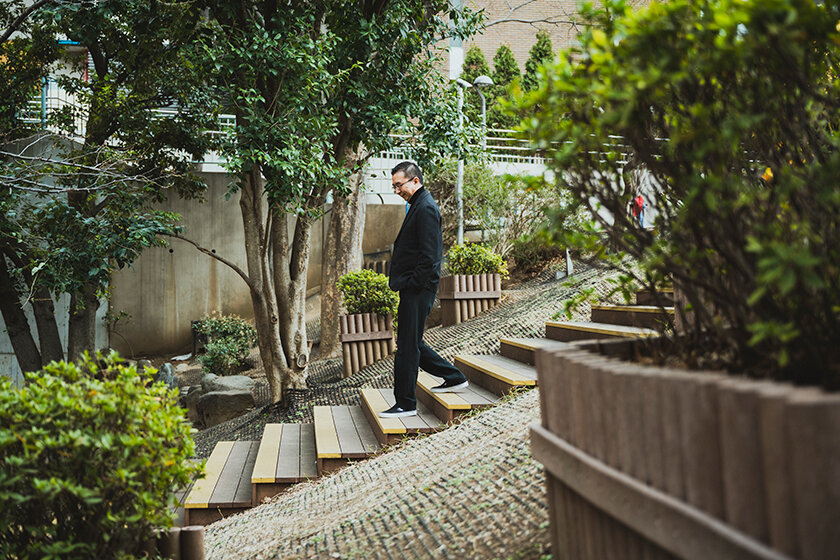
From a society with restrictions that deprive human order to urban development with more choices.
The UNIQLO PARK Yokohama Bayside Store is a mysterious park that I had a hand in creating last year. The first floor of the building has a UNIQLO store, the second floor is GU, and the third floor features children's clothing from both stores. For example, if someone wanted to go to GU, they could take the escalator inside up from the UNIQLO store, or they could use the stairs outside, which are part of a park, to go up and directly enter the store from the second floor. After visiting GU, they can go up and buy kid's clothes on the third floor. Then, when leaving, use the slide in the park to go down and head for the parking lot. The vertical divisions between park and building and public and private property have all blended together in a good way.
UNIQLO PARK Yokohama Bayside store
A three-floor UNIQLO store overlooking Yokohama Bayside Marina. The building has a sloped shape, with the entire sloped side serving as a park. When creative director Kashiwa Sato saw a model of the store with an outside staircase, which was one of the ideas Mr. Fujimoto had come up with through trial and error in repose to the client's request to "create a store that has never existed," he said, "I like this." It seems that one phrase determined the direction. To encourage people to climb the stairs, Mr. Fujimoto said, "I came up with the concept of making it a playground for children and thought adding a big slide would make it fun."
©Nacása & Partners
In the first place, I think cities were originally created to have a variety of things gathered together to give people more choices. However, with the progress of urbanization, it is not clear whether there are more choices or not. Especially during the COVID-19 pandemic, I feel that options are being narrowed down. I feel human beings are not suited to living in a way in which they have to do things a certain way. Richness comes from being able to make our own choices such as "I'll eat here today" or "I'll work around here today."
On the other, human society also tries to maintain order by limiting and restricting things like "this is not allowed" and "please behave like this." This may maintain the appearance of order, but is it really human order? When I think about it, I think it would be better to move toward having more options rather than limiting them. If we can have cities where things coexist and blend together as a whole, it will lead to an environment where people can choose to do this or that themselves. It is not about "this is the way it should be," but rather "this is good, and that is also good." This is a way of coexisting with diverse values, and it also expands one's options. If we can design a situation in which this is positively established, I think that towns and architecture will improve.
In that process, it would be great to see more and more ambitious attempts at development occur. In the Tokyo Torch - Tokiwabashi Project in Front of Tokyo Station that I am currently involved in, we are going to create a hill-like structure on the upper floors of the Torch Tower skyscraper. Normally, if you build a regular skyscraper, you can create a good one without any problems. However, in this case, the building owners wanted to "take on a future-orientated challenge." The COVID-19 pandemic may have an impact, but I feel more and more businesses and developers think this way. A fundamental question has risen in everyone's mind, "Can we continue to build cities in the same way?" This does not mean to reject the current state; rather, it is a positive idea exploring whether a city can become more interesting. It is a sign that everyone is trying to open up new possibilities for cities. In that sense, I feel that this is a very exciting project.
TOKYO TORCH
A development project located in front of Tokyo Station. Mr. Fujimoto, who was selected as one of the "three designers who will lead the next generation," is in charge of designing the top of the more than 300-meter-tall Torch Tower. "When I thought about how places for people would expand in the future, I thought it would be good to have something like a "hill" floating 300 meters above in the sky. A hill has a sloped surface so it is physical, and the places that would normally divide the first and second floors can be gently connected," said Mr. Fujimoto.
Photo: Mitsubishi Jisho Sekkei Inc.
An image of a modern society shaped by the consonance of individuals. The architecture of the future lies beyond that.
As time continues to progress and we reach around the year 2050, the coexistence of nature and the urban environment will inevitably be a theme. Right now, we can say that the dawn of incorporating greenery into architecture has finally begun. So, for the time being, we are putting trees directly into the buildings. In the near future, it won't be just about adding greenery, as much more diverse and complex architecture itself will be possible: the way the inside and outside of a building are related, the addition of topographical elements such as the hill in the Torch Tower mentioned earlier. As a result, buildings themselves will probably become extensions of the earth.
Now, and in the past, my greatest matter of concern and interest is "places for people." Rather than architecture in a narrow sense, I am always interested in what the future living environment where people will be active will be like. Relationships between individuals are developed to form a society, and with the introduction of information technology and other concepts, various relationships are born. That becomes the spirit of the times and creates a large social image. I believe that social image and the architecture that will be created going forward are inseparable. The formation of human society and how relationships between people work are directly linked to the future of architecture. So, I am interested in this in a broad sense and thinking about future urban environments and living environments.
Within that, it isn't easy to think about what is universal.... There are times when I wonder if it is OK to think of the shape of the human body as being unchanging. Given that the circumstances surrounding people are changing at an incredible rate, I end up wondering if there is something universal in the first place. However, when I think about the fact that when we look at a building that was constructed 2000 years ago, we say, "Wow, that's amazing!" I wonder if there is something we are building now that people 2000 years into the future will also find amazing. For that reason, I think it is best if my awareness is constantly renewed so that I can make new discoveries. In fact, every time I get involved in various projects, I feel like I am discovering the richness of the world. I think that is why I continue to stay involved with design.
Editor's thoughts
Sou laughed and said, "I grew up in a place full of nature, so I do not have much admiration for nature itself." However, I feel that Sou's creations seamlessly blend the "boundaries" between the natural and artificial we humans have imposed. And softly assimilate them as a wonderful gift to nature, and of course, to people as well. Different from a stereotypical genius, Sou is a genius nonetheless. He is a quiet and unassuming genius and personality. And I am sure he will continue to show us spaces the likes of which have never been seen before.
RANKING
ALL
CATEGORY




